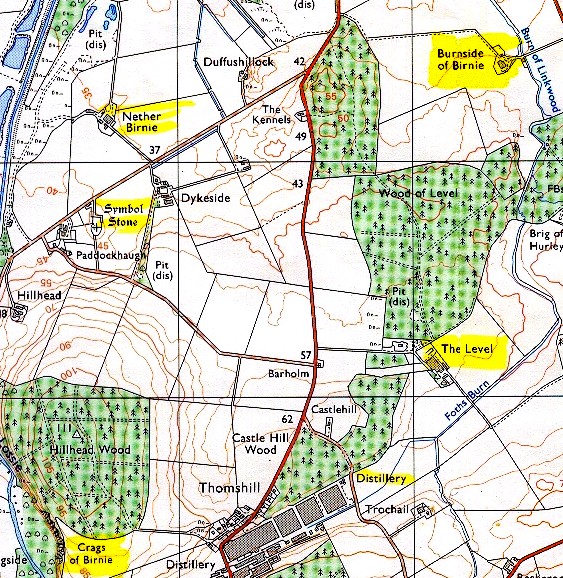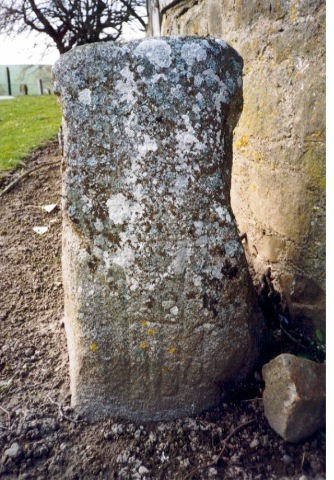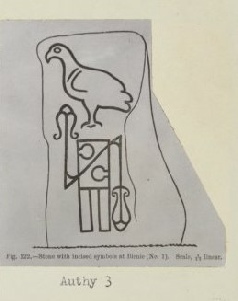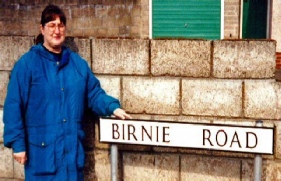

Birnie Parish
Birnie Kirk

Birnie Palace
(Birnie Castle)




Pictish Stone


1798 Parish Survey
Situation, Soil, Climate. Besides the valleys which the rivers occupy, and may be conceived to have formed, in the chain of mountains ftretched along the fouthern fide of the low lands of the Moray, one valley, in which there is no river, opens fourthward from the wideft part of the plain, where the weftern fide of the parifh of Elgin borders with the eaft of Birnie, and extends quite through the mountain to the banks of the Spey. A fquare hill, about 6 miles long the bafe of every fide, is hereby infulated on the fide of this defile, having the plain of Rothes on the fourth, on the eaft partly Rothes, and partly Speymouth, and the champaign of Moray on its northern fide. The Mountain on the weftern fide of this defile extends beyond its length to either hand, from Craig Elachy overhanging the Spey, to the lake of Mofstowie in the parifh of Alves; as if that river, once occupying a channel along its bafe 60 feet higher than its prefent bed, had then poured its whole ftream through this defile, and winding over the plain, on a variety of courfes during different ages, into the fea.
The parifh of Birnie is placed in the entrance of this defile, extended partly on the plain, and partly on the fide of the mountain, through which the water of Loffie, iffuing from its own valley in the mountain, bends from its original direction parallel to the Firth, winds northward along the plain, doubled almoft in its ftream by the increafe of three brooks, the Lenoch, Bardon, and Rafcrook, each tumbling from the hill through its own narrow vale. It appears by the Chart. Mor. That the parifh has bore the name Brenuth fince times that were ancient in the beginning of the 13th century, a Gaelic appellation, fignifying, in its literal interpretation, the north hill fide. The cultivated land is generally a fhallow (missing text), a fhallow foil, fandy, ftoney, and fteep, lying on a bed of rock, or much concreted gravel. Thefoil on feveral fields on the banks of the Loffie is loam incumbent on fand, or clay; and over the whole parifh, plots of mooifh or pear foil are found. The air, though healthful, is rather moift and cold in the hills, where thefroft is earlier and fharper, and more rain and fnow fall, than on the plain.
State of Property. The whole parifh was part of the lands of the bifhrick. The Regent Earl of Moray obliged Bifhop Hepburn, on the pretence of entertaining his outlawed nephew Bothwell, about the year 1566, to annex it with other lands, to his private eftate. The hills affording game in abundance, one croft, for the Earl's accommodation in the hunting feafon, was affigned to the vintner, for the yearly payment of a rofe, and another to the blacksmith for the annual delivery of a horfe-
State Eccefiafticial. The church was the firft cathedral in the diocefe. There is no account when the prefent fabric was built; although fmall, it is wholly of free ftone, neatly fquared and cut, and is dftinguifhed by its nave and choir. The fourth Bifhop, Simon de Tonie, was buried in it in the year 1184. The ftipend is Lxx,16s. 5d. and 38 bolls 2firlots of victual. The glebe is nearly 9 acres. The right of patronage appertains to the Earl of Moray. The falary of the fchool is L.5; ans as the number of fouls in the parifh, of whom 2 only are Seceders, amounts to 402, the compliments of the office, arifing from about 20 fcholars, must be in-
Mifcellaneous Information. The people, though poor, are induftrious, cheerful, and temperate: mufic is their favorite diverfion; many play on the bag pipe, and feveral on the violin. There is a very ancient bell of copper and filver; it is called the Coronach: its figure is not round; it is fquare, having two fides wider than the other two: all of then are cut into open decorations near the top. It was made in Rome, and confecrated by the Pope. The confecrated font remains alfo entire, though now tumbled about without reverence in the church-
A ridge of rock extends from the eaft to weft through the middle of the parifh. And quarries of free ftone, flate, and lime-
Chapter III, pages 142-
